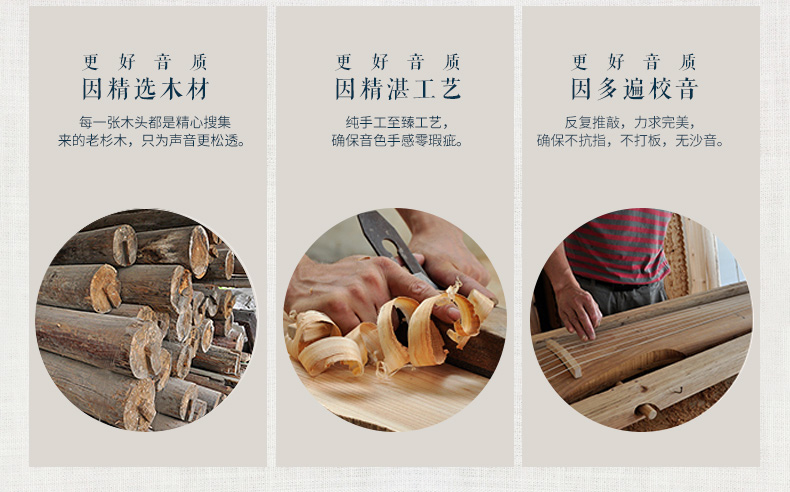买好琴就选“久音古琴” 电话:15150827214 客服微信号:gcds325 (联系客服观看实拍视频)
Efficient Learning of Guqin: Ten Methods for Beginners
Guqin, one of the oldest plucked instruments in China, carries profound cultural significance and artistic value. However, for beginners, how to learn guqin efficiently, quickly master techniques, and improve performance skills is a common challenge. The Sohu article "Xianhe Guqin—Ten Efficient Learning Methods for Beginners" offers valuable insights and practical methods. Here is a summary and interpretation of its core content.
I. Familiarize Yourself with the Music: Cultivate Musical Memory and Aesthetic Sense
Before learning a guqin piece, choose a version you like and listen to it repeatedly until you can hum it from memory. This not only helps you quickly grasp the melody and rhythm during the learning process but also enables smoother transitions between musical phrases, making your learning much more efficient.
II. Analyze the Musical Structure: Understand the Story Behind the Music
Understand the background of the piece and its artistic conception. Clarify the musical phrasing, breath points, structural divisions, and the relationships between different sections. This not only helps you better understand the music but also gives you a preliminary idea of the dynamics, tone color, and tempo changes required for the right hand. This understanding allows you to more accurately express the emotions of the piece.
III. Memorize the Score: Enhance Focus and Accuracy
The guqin has only "hui" (dots) on its surface, without fixed frets. Therefore, memorizing the score is essential after initially playing from the notation. Memorization allows you to free your eyes from the score, focusing on the left-hand positions, thereby improving accuracy and concentration while playing.
IV. Verify the Fingering: Standardize Performance Techniques
After learning the fingering, repeatedly check the fingering for both hands. The fingering in guqin scores is carefully considered and rational. Standardized fingering practice is crucial for performance quality, especially given the relatively slow tempo of guqin playing. Long-term standardized practice prevents arbitrary fingering choices that can negatively impact performance.
V. Determine the Number of Practice Repetitions: Repetition is the Key to Success
Students are advised to practice a single piece over 200 times, or even 300 to 500 times, to achieve proficiency. Extensive repetition not only helps familiarize you with the piece but also enhances performance fluency and stability.
VI. The "Bean-Counting" Method: Quantify Your Practice Progress
Prepare a jar of beans (yellow, black, or red beans) and transfer one bean to another jar after each practice session. When the jar is empty, the piece is essentially mastered. Alternatively, you can use a tally system with "zheng" characters to track practice counts. This method visually quantifies your progress and motivates consistent practice.
VII. Targeted Practice: Overcome Difficult Sections
The "targeted practice" method, proposed by Mr. Gong Yi, involves identifying and repeatedly practicing the most challenging sections of a piece. Guqin pieces often have significant differences in technical difficulty across sections. By focusing on these difficult parts, you can balance the overall technical demands of the piece. Spend most of your practice time on these challenging sections rather than simply playing through the piece from beginning to end.
VIII. Variable-Speed Practice: Enhance Tempo Stability
Follow the principle of "practicing fast pieces slowly and slow pieces fast." For fast sections, slow down the tempo to amplify each note, enhance coherence between notes, and improve finger dexterity. Maintain a steady tempo during slow practice to train your ability to control speed. Gradually increase the tempo from slow to normal performance speed, and even faster. This method is highly effective for improving the stability of your playing speed.
IX. Blind Practice: Enhance Tactile Sensitivity and Focus
Once you have thoroughly mastered a piece, try "blind practice," where you play without looking at your hands or the instrument. Blind practice helps you rely on tactile memory to accurately locate positions on the guqin. This method forces you to be more attentive and reduces the likelihood of mistakes during normal performance.
X. Mental Practice: Improve Skills Anytime, Anywhere
Even without the instrument, you can practice mentally. Lie down and visualize yourself playing the guqin, with the melody playing in your mind from start to finish. This method not only reinforces memorization and fingering but also enhances your overall interpretation of the piece. It helps you discover details that you might have overlooked during regular practice.
Conclusion
Learning guqin is a gradual process that requires patience, perseverance, and the right methods. By adopting these ten efficient learning methods, beginners can quickly master guqin techniques and improve their performance skills. The charm of guqin lies not only in its melodious sound but also in its profound cultural heritage. May every guqin learner find peace and fulfillment through music, making guqin an integral part of their lives.
古琴
>> 古琴和古筝的区别 古琴牌子 古琴购买 古琴几根弦 古琴
>> 一个专注古琴的知识分享网站

好古琴,久音造!
For a high-quality Guqin, choose "Jiuyin Guqin".
Phone: 15150827214
Customer Service WeChat: gcds325 (Contact customer service to view real-time videos.)
